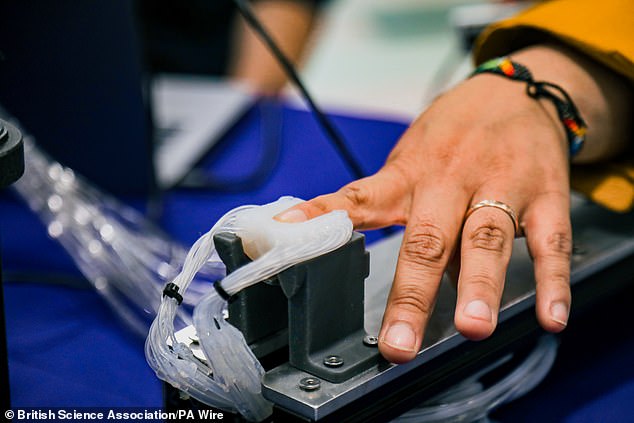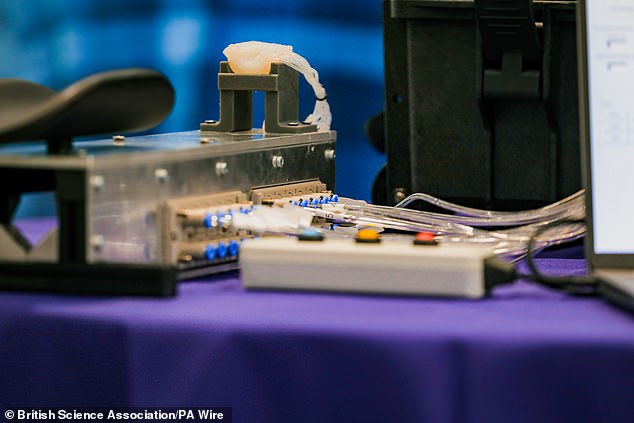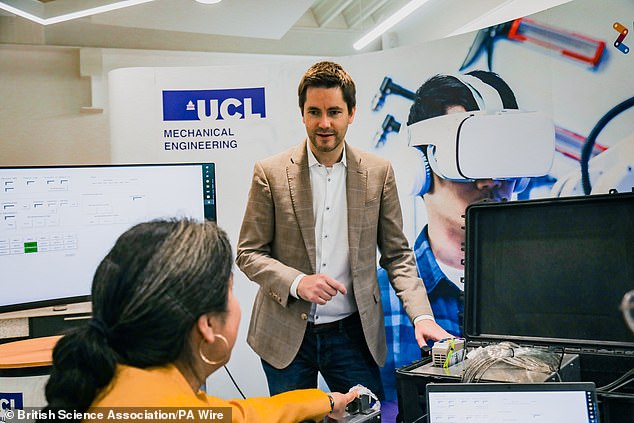How you may soon be able to hold the hand of a loved one who lives thousands of miles away – via a new soft device on your fingertip
Long distance friendships and relationships can be difficult at best.
But thanks to new technology, you may soon be able to walk hand in hand with a loved one who lives thousands of miles away.
Experts have designed a device with soft fingertips that enables a realistic sense of touch – one of the most complex sensations in the human body.
The Bioinspired Haptic System (BAMH) works by simulating all four touch receptors in the human finger using vibrations of different speeds and strengths at multiple locations.
The team behind the device say they are confident they have the technology to create a glove that could eventually enable remote social interaction and the sensation of holding a hand.
Researchers have developed a new technology that they claim can ‘simulate touch as naturally as real-life sensations’ (Pictured: Dr Sara Abad, a roboticist in the Department of Mechanical Engineering at University College London (UCL) at the BAMH)

The device works by stimulating nerve cells that respond to touch using vibrations (pictured: the BAMH)

The team behind the device said they believe they have the technology to create a glove that could eventually enable remote social interaction and the feeling of holding a hand
For example, someone in London could “hold” the hand of a dying relative in Sydney and both could feel the touch in real time.
Experts also said it could be useful in health care, as a diagnostic tool for conditions involving loss of contact, such as metacarpal tunnel syndrome or even diabetes.
It could even be used in remote healthcare, where surgeons could use the device to distinguish between healthy and cancerous tissue.
The feasibility of the technology was published yesterday (Wednesday) in the journal Nature Communications and the team hopes to recruit at least 10 people who suffer from sensory loss for a clinical trial in the coming months.
Dr Sara Abad from University College London (UCL) said: ‘The sense of touch is the least understood of all the senses, and that is because of its complexity.

The new device, called BAMH (innovative bioinspired haptic system), works by stimulating nerve cells that respond to touch using vibrations
‘The skin is one of the largest organs of our body and provides different types of information, such as texture and edges.
‘It also tells us what kind of stimulus we are receiving, for example a constant stable stimulus or a vibration.
‘One area where the device can be used is in social applications. For example, with the pandemic and globalization, it is very likely that you have family who do not live in the same city as you.
‘Unfortunately, there is a barrier with video calls. For social connection, which is important, you need touch, but video calls don’t offer that.
‘The resulting technology provides a way to integrate touch into our virtual social interactions and could also serve as a diagnostic tool for tactile perception in patients experiencing sensory loss.’
The team presented their technology at the British Science Festival at the University of East London.
Professor Helge Wurdemann, who also worked on the device, added: ‘We believe we have the technology here that will enable us to design a glove.
‘We are investigating the possibility of combining multiple fingers.’
